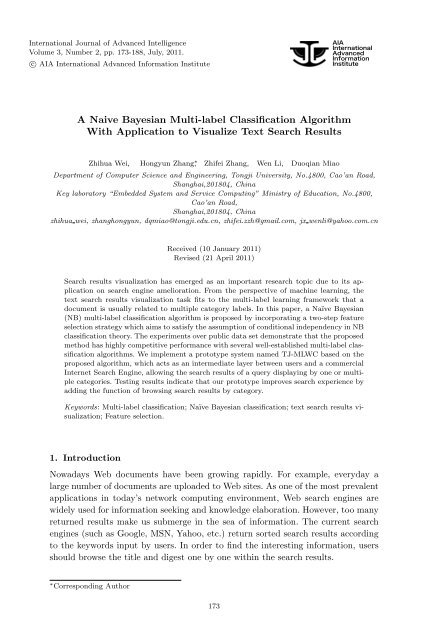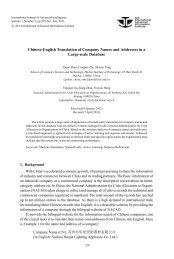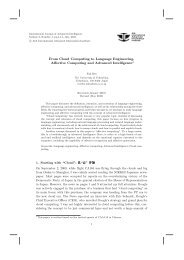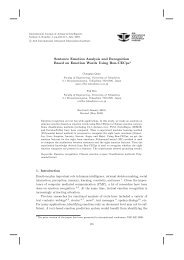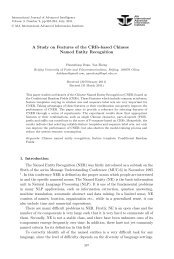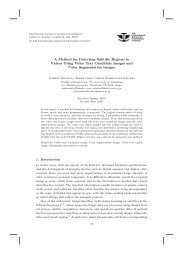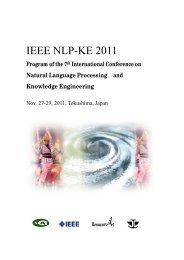A Naive Bayesian Multi-label Classification Algorithm With ...
A Naive Bayesian Multi-label Classification Algorithm With ...
A Naive Bayesian Multi-label Classification Algorithm With ...
Create successful ePaper yourself
Turn your PDF publications into a flip-book with our unique Google optimized e-Paper software.
International Journal of Advanced Intelligence<br />
Volume 3, Number 2, pp. 173-188, July, 2011.<br />
c⃝ AIA International Advanced Information Institute<br />
A <strong>Naive</strong> <strong>Bayesian</strong> <strong>Multi</strong>-<strong>label</strong> <strong>Classification</strong> <strong>Algorithm</strong><br />
<strong>With</strong> Application to Visualize Text Search Results<br />
Zhihua Wei, Hongyun Zhang ∗ , Zhifei Zhang, Wen Li, Duoqian Miao<br />
Department of Computer Science and Engineering, Tongji University, No.4800, Cao’an Road,<br />
Shanghai,201804, China<br />
Key laboratory “Embedded System and Service Computing” Ministry of Education, No.4800,<br />
Cao’an Road,<br />
Shanghai,201804, China<br />
zhihua wei, zhanghongyun, dqmiao@tongji.edu.cn, zhifei.zzh@gmail.com, jx wenli@yahoo.com.cn<br />
Received (10 January 2011)<br />
Revised (21 April 2011)<br />
Search results visualization has emerged as an important research topic due to its application<br />
on search engine amelioration. From the perspective of machine learning, the<br />
text search results visualization task fits to the multi-<strong>label</strong> learning framework that a<br />
document is usually related to multiple category <strong>label</strong>s. In this paper, a Naïve <strong>Bayesian</strong><br />
(NB) multi-<strong>label</strong> classification algorithm is proposed by incorporating a two-step feature<br />
selection strategy which aims to satisfy the assumption of conditional independency in NB<br />
classification theory. The experiments over public data set demonstrate that the proposed<br />
method has highly competitive performance with several well-established multi-<strong>label</strong> classification<br />
algorithms. We implement a prototype system named TJ-MLWC based on the<br />
proposed algorithm, which acts as an intermediate layer between users and a commercial<br />
Internet Search Engine, allowing the search results of a query displaying by one or multiple<br />
categories. Testing results indicate that our prototype improves search experience by<br />
adding the function of browsing search results by category.<br />
Keywords: <strong>Multi</strong>-<strong>label</strong> classification; Naïve <strong>Bayesian</strong> classification; text search results visualization;<br />
Feature selection.<br />
1. Introduction<br />
Nowadays Web documents have been growing rapidly. For example, everyday a<br />
large number of documents are uploaded to Web sites. As one of the most prevalent<br />
applications in today’s network computing environment, Web search engines are<br />
widely used for information seeking and knowledge elaboration. However, too many<br />
returned results make us submerge in the sea of information. The current search<br />
engines (such as Google, MSN, Yahoo, etc.) return sorted search results according<br />
to the keywords input by users. In order to find the interesting information, users<br />
should browse the title and digest one by one within the search results.<br />
∗ Corresponding Author<br />
173
174 Z. Wei, H. Zhang, Z. Zhang, W. Li, D. Miao<br />
Focusing on above problems, some researchers begin to explore more advanced<br />
information retrieval methods. Generally speaking, there are two ways. One is semantic<br />
based information retrieval which uses semantic information to understand<br />
the documents and queries. 1 The other is machine learning based method which uses<br />
model learned from history data to reorganize Web documents such as classification<br />
and clustering. This paper mainly discusses the later, that is, the improvement of<br />
information retrieval based on machine learning.<br />
Web search results visualization is a process that layouts search results in a more<br />
clear and coherent way according to the content of each result. It aims at improving<br />
the search efficiency and accuracy and ameliorating users’ browsing experiences.<br />
Prevalent technique for this task is text clustering. It regards the visualization task<br />
as an unsupervised pattern classification problem. Following the methodology of<br />
pattern classification, text features are first extracted from texts to represent the<br />
document, and then the document is assigned to a cluster in which documents have<br />
high similarity. Generally, the “name” of cluster is given automatically according to<br />
the feature words of documents in this cluster. Related researches could be found<br />
in literatures. 2,3,4,5<br />
The search engines based on clustering technology already exist such as<br />
Vivisimo a and Grokker b . However, there is a problem that the extracted “name” of<br />
each cluster is far from expressing the main contents of its cluster. In this case, it’s<br />
difficult for users to locate interesting information in a corresponding cluster. This<br />
made the process of visualizing search results less significant.<br />
Unlike the traditional pattern classification problems in which each pattern has<br />
a unique <strong>label</strong>, a document may be associated with more than one <strong>label</strong> (e.g. a document<br />
may include the content about economy and computer). <strong>Multi</strong>-<strong>label</strong> learning<br />
originated from researches on text categorization problems, which each document<br />
may belong to several predefined <strong>label</strong>s. In this case, each document in training<br />
set is associated with a set of <strong>label</strong>s, and the task is to output a <strong>label</strong> set for each<br />
unseen document through analyzing training documents with known <strong>label</strong> sets.<br />
In this paper, we borrow the idea of granularity computing 6 to display search<br />
results in a more refined granularity level-category. A Naïve <strong>Bayesian</strong> <strong>Multi</strong>-<strong>label</strong><br />
<strong>Classification</strong> approach is proposed to handle the web text search results visualization<br />
problem. Feature selection strategy is concerned to improve classification<br />
performance. A prototype system TJ-MLWC is designed as an application example.<br />
In TJ-MLWC, users could look for a document within some interesting classes.<br />
In the same time, a document could be found in various corresponding classes.<br />
The rest of this paper is organized as follows. Section 2 reviews the related<br />
works of visualizing text search results and multi-<strong>label</strong> learning. Section 3 proposes<br />
the Naïve <strong>Bayesian</strong> <strong>Multi</strong>-Label (NBML) approach. Section 4 reports experimental<br />
results on public data set. Section 5 presents the prototype system TJ-MLWC.<br />
a Vivisimo Search Engine. http://www.vivisimo.com.<br />
b Grokker Search Engine. http://www.grokker.com.
A NBML to Visualize Text Search Results 175<br />
Finally, Section 6 summarizes and sets up several issues for future work.<br />
2. Related Works<br />
2.1. Related works on visualizing text search results based on<br />
machine learning<br />
Visualizing search results by methods based on machine learning is one obvious solution<br />
for dealing with information overload. Clustering is one way that allows users<br />
to view categorized results without having to deal with the costs and complexities of<br />
building taxonomies (see, for example, the Vivisimo search engine). This advantage<br />
makes clustering technique prevalent in the field of visualizing search results. D.<br />
Roussinov and H. Chen proposed an approach of summarizing query results by automatic<br />
text clustering and implemented a prototype. 2 G. Mecca et al. used Latent<br />
Semantic Indexing on the whole document content and proposed a strategy, called<br />
Dynamic Singular Value Decomposition (SVD) Clustering, to discover the optimal<br />
number of singular values to be used for clustering purpose. A tool based on this algorithm<br />
has been integrated into the Noodles search engine. 3 Nicole Lang Beebe et<br />
al. proposed a kind of post-retrieval clustering of digital forensic text string search<br />
results specifically by using Kohonen self-Organizing Maps, a self-organizing neural<br />
network approach. 4 Zamir and Etzioni made an empirical comparison of standard<br />
ranked-list and clustered presentation systems when designing a search engine interface<br />
named Grouper, and reported substantial differences in use patterns between<br />
the two. 5 Some researchers have experimented with highly metaphorical visualizations.<br />
For example, Cugini et al. presented users with structural overviews of<br />
result sets and promoted visualization as the best approach to dealing with broad<br />
search tasks. 7 Visualization of this type appears to make it easier for users to locate<br />
worthwhile information and to comprehend search results.<br />
Recently, some researches use topic map based on probabilistic graph model<br />
theory to improve representation of search results. Newman et al. explored semantic<br />
visualizations of Web search results based on topic map. 8 Their topic maps are<br />
based on a topic model of the document collection, where the topic model is used to<br />
determine the semantic content of each document. The topic model represents documents<br />
as a mixture of topics, which is a more flexible representation than k-Means<br />
clustering, 9 where a document belongs to just one topic. This richer representation<br />
means that one can navigate to related articles via any of the topic facets<br />
in a given article (this is not possible for k-Means). Furthermore, since the topic<br />
model is based on a generative probabilistic model, it can be flexibly extended to<br />
include other meta-data and attributes, such as authors, citation links, and subject<br />
headings, and therefore it is also preferred over Nonnegative Matrix Factorization<br />
(NMF). 10<br />
All these researches improved search engine performance to some extent. However,<br />
the methodology of clustering suffers from the difficulty of naming the clusters.<br />
Users could not comprehend the content of a cluster only from the words automat-
176 Z. Wei, H. Zhang, Z. Zhang, W. Li, D. Miao<br />
ically given. It is still very difficult for user to find interesting information.<br />
2.2. Related works on multi-<strong>label</strong> classification approaches<br />
Traditional single-<strong>label</strong> classification is concerned with learning from a set of examples<br />
that are associated with a single <strong>label</strong> l from a set of disjoint <strong>label</strong>s L,<br />
|L| > 1. In multi-<strong>label</strong> classification, the examples are associated with a set of<br />
<strong>label</strong>s Y ⊆ L. 11<br />
Some multi-<strong>label</strong> classification algorithms have been successfully designed for<br />
the application of text classification. Majority of traditional machine learning algorithms<br />
for single <strong>label</strong> classification problem have been extended to multi-<strong>label</strong><br />
cases. Representative research works include the AdaBoost.MH 12 which is the extension<br />
of AdaBoost, the extensions of several neural network algorithms, 13,14,15<br />
the extension of SVM, 16 the extensions of Naïve <strong>Bayesian</strong>, 17,18 the extension of<br />
Maximum Entropy, 19,20 the extension of decision tree, 21 the extensions of some<br />
lazy-style algorithms 22,23,24 etc. Recently, several algorithms have also been proposed<br />
to improve the performance of learning systems through explore additional<br />
information provided by the correlation of class <strong>label</strong>s 25,26,27,28,29,30,31 or un<strong>label</strong>ed<br />
data. 32,33 Naïve <strong>Bayesian</strong> classification algorithm, as one of the probabilistic generative<br />
model, has natural advantage for multi-<strong>label</strong> learning problem. McCallum 17<br />
proposed a <strong>Bayesian</strong> approach to multi-<strong>label</strong> document classification, where a mixture<br />
probabilistic model (one mixture component per category) is assumed to generate<br />
each document and the EM 34 algorithm is used to learn the mixture weights and<br />
the word distributions in each mixture component. Min-ling Zhang et al. adapted<br />
traditional Naïve <strong>Bayesian</strong> algorithm to deal with multi-<strong>label</strong> instances and incorporated<br />
feature selection mechanisms into classifier to improve its performance. 18<br />
Other probabilistic generative models are also used for multi-<strong>label</strong> text classification<br />
such as parametric mixture models (PMM1, PMM2). 35 Above NB multi-<strong>label</strong><br />
classification algorithms mainly focused on modeling the relations between words<br />
and classes and classification performances are improved to some extent. However,<br />
a complex model always accompanies highly computational costs. Our work aims<br />
at classifying text search results real-time by using multi-<strong>label</strong> classifiers with low<br />
computational complexity. Consequently, a kind of less complex feature selection<br />
strategy is more proper for this task.<br />
3. Naïve <strong>Bayesian</strong> <strong>Multi</strong>-<strong>label</strong> <strong>Classification</strong> Approach<br />
Naïve <strong>Bayesian</strong> (NB) algorithm is efficient. For the real-time system, it has a wide<br />
application such as Spam filtering system. For the task of multi-<strong>label</strong> classification,<br />
classic NB classifier should be adapted to multi-<strong>label</strong> data. In addition, there is a<br />
factor that may negatively affect its performance. NB classifier has the assumption<br />
of class conditional independence, i.e. the effect of a feature value on a given class<br />
is independent of the values of other features. In real world applications, however,
A NBML to Visualize Text Search Results 177<br />
this assumption does not usually hold which in turn may deteriorate the learning<br />
performance. 18<br />
In this part, the NB classifier adapted for multi-<strong>label</strong> text classification is designed.<br />
The two-step feature selection strategy is proposed to obtain the features<br />
as independent as possible.<br />
3.1. Naïve <strong>Bayesian</strong> <strong>Multi</strong>-Label (NBML) classifier for text<br />
classification<br />
For a random document d ∈ D associated with <strong>label</strong> set Y ⊆ L , |L| binary NB<br />
classifiers H l : d → {l, ¬l} are learned, one for each different <strong>label</strong> l in L . That is,<br />
the original data set is transformed into |L| data sets D l that contain all examples<br />
of original data set, <strong>label</strong>ed as l if the <strong>label</strong>s of the original example contained l and<br />
as ¬l otherwise. In this case, the multi-<strong>label</strong> classification problem is transformed<br />
into the combination of several single-<strong>label</strong> NB classifiers.<br />
For the classification of a new document d , this method outputs a set of <strong>label</strong>s<br />
which is the union of the <strong>label</strong>s that are output by the |L| classifiers.<br />
H(d) = ∪ l∈L<br />
{l : H l (d) = l} (1)<br />
Each single-<strong>label</strong> NB classifier works according to the classic NB theory which<br />
is described as follows.<br />
For a random document d j , its feature is (a 1 , a 2 , ...a m ) , here a k is kth feature in<br />
document d j . Document <strong>label</strong> set is L = {l 1 , l 2 , ..., l n } . The conditional probability<br />
of document d j with relate to each class <strong>label</strong> P (l i |d j ) is defined as follows.<br />
P (l i |d j ) = P (l i)P (d j |l i )<br />
P (d j )<br />
Because P (l i ) does not change the result, it can be ignored. P (d j |l i ) can be<br />
obtained from following formula.<br />
(2)<br />
P (d j |l i ) ≈ m Π<br />
k=1<br />
P (a k |l i ) (3)<br />
Here, P (l i ) and P (a k |l i ) can be estimated according to following formulas.<br />
∧<br />
P (L = l i ) = N i<br />
N<br />
(4)<br />
∧<br />
P (a k |l i ) =<br />
1 + N ki<br />
∑<br />
m + m (5)<br />
N ki<br />
Here, N i is the amount of texts having the <strong>label</strong> l i . N ki is the total frequency<br />
of word a k appearing in documents in category l i . For single-<strong>label</strong> classifier, the<br />
k=1
178 Z. Wei, H. Zhang, Z. Zhang, W. Li, D. Miao<br />
predicted category of document d j is the maximum of probability of these categories.<br />
In the case of multi-<strong>label</strong> classification, we use a parameter P thres to represent the<br />
average of posterior probability of document d j in each class as follows.<br />
P thres = 1 n<br />
n∑<br />
P (l i |d j ) (6)<br />
When P (l i |d j ) ≥ P thres , we consider that d j has <strong>label</strong> l i . In this strategy, new<br />
document d has all <strong>label</strong>s which satisfy P (l|d) ≥ P thres . The Eq.(1) could be described<br />
as follows.<br />
i=1<br />
H(d) = ∪ l∈L<br />
{l : P (l|d) ≥ P thres } (7)<br />
The least amount of <strong>label</strong>s of a document is “1” when the probability of the<br />
document belonging to a class is obviously higher than that of the document belonging<br />
to other classes. The maximum amount of <strong>label</strong>s of a document is “n” when<br />
the probabilities of the document belonging to each class are equal.<br />
3.2. Two-step feature selection strategy<br />
Feature selection is a space reduction method which attempts to select the more discriminative<br />
features from preprocessed documents in order to improve classification<br />
quality and reduce computational complexity. As many words are extracted from<br />
documents, we remove stop list words and then perform two-step feature selection.<br />
Firstly, discriminative features are selected based on DF (Document Frequency)<br />
and χ 2 statistical analysis. 36 Then FCBF (Fast Correlation-Based Filter Solution)<br />
algorithm proposed by Yu and Liu 37 is conducted to filter relevant and redundant<br />
features among classes.<br />
3.2.1. The first step feature selection<br />
The number of words in each class is great. However, most of them occur only one<br />
or two times. This kind of words is not representative for a class. It is necessary to<br />
cancel these words in a class before further feature selection. We adopt DF to filter<br />
this kind of features, which is defined as follows.<br />
In a corpus D, each text belongs to a class set Y . Here, Y ⊆ L , L = {l 1 , l 2 , ..., l n }<br />
is the class set defined before classification. Relative text frequency is:<br />
T ext freq relative ij = T ext freq ij<br />
N i<br />
(8)<br />
Here, N i is the quantity of texts with <strong>label</strong> l i in training set. T ext freq ij is the<br />
number of texts with <strong>label</strong> l i which include word j. <strong>Algorithm</strong> 1 is designed to filter<br />
rare features within a class.
A NBML to Visualize Text Search Results 179<br />
<strong>Algorithm</strong> 1.<br />
Begin<br />
For l i ∈ L, L = {l 1 , l 2 ...l i ...l n },<br />
T erm ′ i = ∅, T erm = ∅;<br />
For word j ∈ T erm i ,<br />
If (T ext freq relative ij < α)<br />
remove word j ;<br />
Else<br />
word j ∈ T erm ′ i .<br />
T erm = {T erm ′ 1, T erm ′ 2...T erm ′ i ...T erm′ n}.<br />
End.<br />
Here, T erm i includes all the words extracted in the documents with <strong>label</strong> l i ,<br />
T erm ′ i includes all the words selected in documents with <strong>label</strong> l i and T erm is word<br />
set selected in training set by <strong>Algorithm</strong> 1.<br />
We construct “feature by class <strong>label</strong>” matrix (noted as Matrix cf ) to select<br />
discriminative features. In Matrix cf , each feature (word) “j” is assigned a numerical<br />
score based on its occurrence within the different document <strong>label</strong>s “l i ”. The choice of<br />
the scoring method in this work is the χ 2 test. There are many other tests available<br />
as summarized by Sebastiani. 38 However, the χ 2 is often cited as one of the best<br />
methods for feature selection. The score of word “k” is:<br />
∑ (O ik − E ik ) 2<br />
i<br />
E ik<br />
(9)<br />
Where O ik is the frequency of word k in documents with <strong>label</strong> l i . E ik represent<br />
the expectation value in the hypothesis of independence of classes and features.<br />
E ik = O i+ × O +k<br />
O ++<br />
(10)<br />
Here, O i+ is the total word frequency on <strong>label</strong> l i and O +k is the accumulation<br />
of occurrence of word k in training set.<br />
3.2.2. The second step feature selection<br />
FCBF algorithm proposed a fast feature filter method which could identify relevant<br />
features as well as redundancy among relevant features without pair wise correlation<br />
analysis. 37 In this algorithm, feature dimensionality is reduced dramatically by<br />
introducing a novel concept, predominant correlation based on symmetrical uncertainty.<br />
Here, FCBF algorithm is conducted on the feature selection results obtained<br />
in the first step. The first step of the above algorithm has a linear time complexity<br />
in terms of the number of features M. The time complexity of second step algorithm<br />
FCBF is O (NMlogM), where, N is the number of instances. 37
180 Z. Wei, H. Zhang, Z. Zhang, W. Li, D. Miao<br />
4. Experiments and Discussions<br />
As reviewed in Section 2, there have been several approaches to solving multi-<strong>label</strong><br />
problems. In this paper, our algorithm NBML is compared with Adaboost.MH, 21<br />
multi-<strong>label</strong> K nearest neighbor (ML-kNN) 24 and the multi-<strong>label</strong> kernel method<br />
Rank-SVM, 16 which are all multi-<strong>label</strong> learning algorithms applicable to various<br />
multi-<strong>label</strong> problems including text classification. We would not compare our<br />
method to the NB multi-<strong>label</strong> classification algorithm proposed respectively by A.<br />
McCallum 17 and Min-Ling Zhang 18 because they have high computational complexity<br />
which is improper for the application of Web search results visualization.<br />
For the sake of well evaluating our classification algorithm, our experiments are<br />
conducted on an public English corpus coming from NTT communication science<br />
research group, which contains real Web pages linked from the “yahoo.com” domain,<br />
where it consists of 14 top-level categories (i.e. “Arts & Humanities”, “Business<br />
& Economy”, etc.) and each category is classified into a number of second-level<br />
subcategories c . By focusing on the second-level categories, we selected 11 out of<br />
the 14 independent text categorization problems. For each problem, the training set<br />
contains 2,000 documents while the test set contains 3,000 documents.<br />
We adopt various evaluation metrics such as Hamming Loss, One-error, Coverage<br />
and Average Precision. The definitions of these metrics could be found in<br />
Ref.12. Tables 1-4 show the comparisons on various metrics between our NBML<br />
and AdaBoost.MH, ML-kNN and Rank-SVM algorithms, where the best result on<br />
each corpus is in bold face. The experiment results of AdaBoost.MH, ML-kNN and<br />
RANK-SVM are cited. 24 <strong>Classification</strong> algorithm of NBML is performed on the free<br />
platform WEKA. 39 Ten-fold cross-validation is carried out on data set. In the first<br />
step of feature selection, we choose α = 0.02.<br />
Table 1. Comparison among different algorithms on Hamming loss<br />
Data Set NBML ML-kNN AdaBoost.MH Rank-SVM<br />
Arts & Humanities 0.0605 0.0612 0.0585 0.0615<br />
Business & Economy 0.0253 0.0269 0.0279 0.0275<br />
Computers & Internet 0.0373 0.0412 0.0396 0.0392<br />
Education 0.0455 0.0387 0.0423 0.0398<br />
Entertainment 0.0544 0.0604 0.0578 0.0630<br />
Health 0.0433 0.0458 0.0397 0.0423<br />
Recreation & sports 0.0610 0.0620 0.0584 0.0605<br />
Reference 0.0314 0.0314 0.0293 0.0300<br />
Science 0.0336 0.0325 0.0344 0.0340<br />
Social & Science 0.0241 0.0218 0.0234 0.0242<br />
Society & Culture 0.0553 0.0537 0.0575 0.0555<br />
Average 0.0429 0.0432 0.0426 0.0434<br />
c Data set available at http://www.kecl.ntt.co.jp/as/members/ueda/yahoo.tar.gz.
A NBML to Visualize Text Search Results 181<br />
Table 1 shows the comparison of Hamming Loss between NBML and other<br />
algorithms. We could find that AdaBoost.MH gives the best performance, MLkNN<br />
and NBML follow and Rank-SVM gives the worst. Hamming Loss evaluates<br />
how many times an instance-<strong>label</strong> pair is misclassified, i.e. a <strong>label</strong> not belonging<br />
to the instance is predicted or a <strong>label</strong> belonging to the instance is not predicted.<br />
AdaBoost.MH is designed to minimize Hamming Loss, thus, it could give better<br />
prediction on instance-<strong>label</strong> pair.<br />
Table 2. Comparison among different algorithms on One-error<br />
Data Set NBML ML-kNN AdaBoost.MH Rank-SVM<br />
Arts & Humanities 0.5756 0.6330 0.5617 0.6653<br />
Business & Economy 0.1420 0.1213 0.1337 0.1237<br />
Computers & Internet 0.4453 0.4357 0.4613 0.4037<br />
Education 0.5105 0.5207 0.5753 0.4937<br />
Entertainment 0.5209 0.5300 0.4940 0.4933<br />
Health 0.3571 0.4190 0.3470 0.3323<br />
Recreation & sports 0.5517 0.7057 0.5547 0.5627<br />
Reference 0.4776 0.4730 0.4840 0.4323<br />
Science 0.5731 0.5810 0.6170 0.5523<br />
Social & Science 0.3572 0.3270 0.3600 0.3550<br />
Society & Culture 0.4502 0.4357 0.4845 0.4270<br />
Average 0.4510 0.4711 0.4612 0.4401<br />
Table 2 shows the comparison of One-error between NBML and other algorithms.<br />
We could find that Rank-SVM gives the best performance, NBML gives the second<br />
best, AdaBoost.MH follows and ML-kNN gives the worst. One-error evaluates how<br />
many times the top-ranked <strong>label</strong> is not in the set of proper <strong>label</strong>s of the instance.<br />
This indicates that NBML could give good prediction on the top-ranked <strong>label</strong> of<br />
instance.<br />
Table 3. Comparison among different algorithms on coverage<br />
Data Set NBML ML-kNN AdaBoost.MH Rank-SVM<br />
Arts & Humanities 5.3471 5.4313 5.1900 9.2723<br />
Business & Economy 2.3210 2.1840 2.4730 3.3637<br />
Computers & Internet 4.4279 4.4117 4.4747 8.7910<br />
Education 3.6840 3.4973 3.9663 8.9560<br />
Entertainment 3.1015 3.1467 3.0877 6.5210<br />
Health 3.0266 3.3043 3.0843 5.5400<br />
Recreation & sports 4.3838 5.1010 4.3380 5.6680<br />
Reference 3.2022 3.5420 3.2643 6.9683<br />
Science 6.4053 6.0470 6.6027 12.4010<br />
Social & Science 3.8422 3.0340 3.4820 8.2177<br />
Society & Culture 5.8794 5.3653 4.9545 6.8837<br />
Average 4.1474 4.0968 4.0834 7.5075
182 Z. Wei, H. Zhang, Z. Zhang, W. Li, D. Miao<br />
Table 3 shows the comparison of Coverage between NBML and other algorithms.<br />
We could find that ML-kNN and AdaBoost.MH give the best performance; Results<br />
of NBML are very close to the best performance. Rank-SVM gives the worst. Coverage<br />
evaluates how far we need, on the average, to go down the list of <strong>label</strong>s in<br />
order to cover all the proper <strong>label</strong>s of the instance. It is loosely related to precision<br />
at the level of perfect recall. This indicates that NBML perform well on recall rate.<br />
Table 4 shows the comparison of Average Precision between NBML and other<br />
algorithms. We could find that NBML gives the best performance, AdaBoost.MH<br />
and ML-kNN follows and Rank-SVM gives the worst. Average Precision evaluates<br />
the average fraction of <strong>label</strong>s ranked above a particular <strong>label</strong> l ∈ Y , which actually<br />
is in Y . This indicates that NBML could give predictions which have the smallest<br />
deviation from the true <strong>label</strong> set of instance.<br />
Table 4. Comparison among different algorithms on Average precision<br />
Data Set NBML ML-kNN AdaBoost.MH Rank-SVM<br />
Arts & Humanities 0.5391 0.5097 0.5526 0.4170<br />
Business & Economy 0.8819 0.8798 0.8702 0.8694<br />
Computers & Internet 0.6205 0.6338 0.6235 0.6123<br />
Education 0.5882 0.5993 0.5619 0.5702<br />
Entertainment 0.6503 0.6013 0.6221 0.5637<br />
Health 0.7355 0.6817 0.7257 0.6839<br />
Recreation & sports 0.5535 0.4552 0.5639 0.5315<br />
Reference 0.6309 0.6194 0.6264 0.6176<br />
Science 0.5234 0.5324 0.4940 0.5007<br />
Social & Science 0.7309 0.7481 0.7217 0.6788<br />
Society & Culture 0.6057 0.6128 0.5881 0.5717<br />
Average 0.6418 0.6249 0.6318 0.6015<br />
We summarize above conclusions: <strong>Algorithm</strong> NBML proposed in this paper has<br />
nearly performance comparing to the famous algorithms (i.e. AdaBoost.MH and<br />
ML-kNN) in the application of multi-<strong>label</strong> text classification.<br />
5. Prototype System TJ-MLWC<br />
This section presents an example of visualizing text search results by using multi<strong>label</strong><br />
classification methodology, named TJ-MLWC2.0 (The version TJ-MLWC1.0<br />
was designed for Chinese text search visualization.). It calls the API of search<br />
engine, performs NB multi-<strong>label</strong> classification on its search results and provides<br />
user the visualized search results by system interface. The classifiers are trained<br />
off-line based on part of the multi-<strong>label</strong> corpus referred in our experiments.<br />
A TJ-MLWC session starts with the user entering her query in the query box.<br />
For example, the user inputs ”Microsoft” and then the system returns the interface<br />
as shown in Fig.1. Here, the <strong>label</strong>s in left box are the categories pre-defined. In the<br />
right, there are all entries returned by search engine. We could choose one or a few
A NBML to Visualize Text Search Results 183<br />
categories, allowing the system to return the entries in specified categories. Each<br />
entry in the right, which different from the displaying form of current prevalent<br />
search engine, has one or more class <strong>label</strong>s added by system.<br />
<br />
Class Labels<br />
Fig. 1. All search results of “Microsoft”<br />
Fig.2 and Fig.3 show the results of query “Microsoft” by choosing the class <strong>label</strong><br />
“Technology”, “Education” separately. The system returns all the entries involving<br />
class <strong>label</strong> “Technology” in Fig.2 and involving class <strong>label</strong> “Education” in Fig.3.<br />
Fig.4 shows the results of involving class <strong>label</strong> “Technology” and “Education” in<br />
the same time. From the figures, we could find that there are some entries belong<br />
to both “Technology” and “Education”. For example, “Microsoft - Wikipedia, the<br />
free encyclopedia”, “Education Overview - Resources” appear in Fig.2 and Fig.3<br />
simultaneously. When we confine the class <strong>label</strong> as “Technology + Education”, the<br />
results will be limited to the scope of entries with the two <strong>label</strong>s as shown in Fig.4.<br />
From the above figures, we could find that a document could appear in more<br />
than one class in our system, which is different from the search engine visualization<br />
system based on clustering algorithms. Theoretically, if a document concerns the<br />
contents in several classes, we could find it in all these classes. However, search<br />
engine based on clustering is more likely to assign a document in a certain cluster.<br />
Usually, the <strong>label</strong> for a cluster obtained by clustering algorithm is hard to reflect<br />
the content of documents in its cluster properly. In this case, the cluster <strong>label</strong>s are<br />
not very effective for user’s locating. In TJ-MLWC, class <strong>label</strong>s are pre-defined to<br />
avoid this problem. Moreover, multiple <strong>label</strong>s ensure that a document could always<br />
be found for users having different interests.<br />
Through testing, we found that there are still some problems to be solved in<br />
system TJ-MLWC. Firstly, it mixes the text search results and other kind of search<br />
results such as image, video and audio. Further works will focus on constructing a<br />
hierarchical classifier which classifies files according to their formation first and then
184 Z. Wei, H. Zhang, Z. Zhang, W. Li, D. Miao<br />
<br />
Technology<br />
Fig. 2. Search results of “Microsoft” when selecting “Technology” class<br />
<br />
Education<br />
Fig. 3. Search results of “Microsoft” when selecting “Education” class<br />
conducts multi-<strong>label</strong> classification on each kind of files. Secondly, we pre-defined the<br />
taxonomy for search results. However, with gradually rectification of Web contents,<br />
documents in new classes will always appear. How can we rectify the taxonomy automatically<br />
according to real demand? All of these problems are our future research<br />
objectives.<br />
6. Conclusions<br />
This paper presents a new multi-<strong>label</strong> classification method based on Naïve <strong>Bayesian</strong><br />
theory. A two-step feature selection strategy based on DF, χ 2 and FCBF algorithm<br />
is incorporated into the method to improve classification performance. Experiments<br />
on public multi-<strong>label</strong> corpus show that our method achieves highly competitive
A NBML to Visualize Text Search Results 185<br />
<br />
Technology <br />
&Education<br />
Fig. 4. Search results of “Microsoft” when selecting “Technology” and “Education” class<br />
performance with several famous multi-<strong>label</strong> classification algorithms. Because our<br />
method embedded high efficiency feature selection algorithm, it has low computation<br />
costs which allows it to be used for the on-line application, especially for<br />
handling high-dimensionality text data. However, our NBML algorithm does not<br />
concern the correlation between <strong>label</strong>s while the dependency among <strong>label</strong>s exists<br />
widely in real applications. Consequently, the improvement of NB multi-<strong>label</strong> classification<br />
itself is our future research issue.<br />
A Web search results visualizing prototype system TJ-MLWC is developed in<br />
this paper. Testing results indicate that this system has the function of browsing<br />
search results by category. It could also avoid the problem of search result visualization<br />
system based on clustering methods. However, with the growing of new<br />
contents on Web, the pre-defined taxonomy is hard to extend automatically and<br />
the classification ability of model trained off-line will be degraded greatly. Semisupervised<br />
multi-<strong>label</strong> classification method could make use of the un<strong>label</strong>ed online<br />
data to improve the performance of classifier. Designing semi-supervised MLNB<br />
classifier that can handle online learning problem is an interesting problem to be<br />
explored.<br />
Acknowledgments<br />
This paper is sponsored by the National Natural Science Foundation of China (No.<br />
60970061 and No. 61075056) and Shanghai Leading Academic Discipline Project<br />
(No.B004).<br />
References<br />
1. F. Ren, D. B. Bracewell. Advanced Information Retrieval, Electr. Notes Theor. Comput. Sci.<br />
225: pp. 303-317, 2009.
186 Z. Wei, H. Zhang, Z. Zhang, W. Li, D. Miao<br />
2. D. Roussinov, H. Chen. Information navigation on the web by clustering and summarizing<br />
query results, Inf. Process. Manage. (IPM) 37(6), pp. 789-16, 2001.<br />
3. G. Mecca, S. Raunich, A. Pappalardo. A new algorithm for clustering search results, Data<br />
Knowl. Eng. 62(3), pp. 504-522, 2007.<br />
4. N. L. Beebe and Jan Guynes Clark. Digital Forensic Text String Searching: Improving Information<br />
Retrieval Effectiveness by Thematically Clustering Search Results, Digital Investigation.<br />
4(2), pp. 49-54, 2007.<br />
5. O. Zamir, O. Etzioni. Grouper: A Dynamic Clustering Interface to Web Search Results, Computer<br />
Networks. 31(11-16), pp. 1361-1374, 1999.<br />
6. D. Miao, G. Wang and Q. Liu. Granular Computing: Past, Present and future, Science Publisher,<br />
2007.<br />
7. J.Cugini, S.Laskowski, & M.Sebrechts. Design of 3D visualization of search results: Evolution<br />
and evaluation. In Proceedings of IST/SPIE’s 12th annual international symposium-electronic<br />
imaging 2000: Visual data exploration and analysis, pp. 23-28, 2000.<br />
8. D. Newman, et al.. Visualizing search results and document collections using topic maps, Web<br />
Semantics: Sci. Serv. Agents World Wide Web, 8(2-3), pp. 169-175, 2010.<br />
9. I.S. Dhillon, D.S. Modha. Concept decompositions for large sparse text data using clustering,<br />
Machine Learning, 42(1/2), pp. 143-175, 2001.<br />
10. T.L. Griffiths, M. Steyvers, J.B.T. Tenenbaum. Topics in semantic representation, Psychological<br />
Review, 114(2), pp. 211-244, 2007.<br />
11. G. Tsoumakas, I. Katakis. <strong>Multi</strong>-Label <strong>Classification</strong>: An Overview, International Journal of<br />
Data Warehousing and Mining, 3(3), pp. 1-13, 2007.<br />
12. R.E. Schapire, Y. Singer. Boostexter: a boosting-based system for text categorization, Machine<br />
Learning, 39(2/3), pp. 135-168, 2000.<br />
13. K. Crammer, Y. Singer. A new family of online algorithms for category ranking, In Proceedings<br />
of the 25th Annual International ACM SIGIR Conference on Research and Development in<br />
Information Retrieval, pp. 151-158, 2002.<br />
14. M.-L. Zhang, Z.-H. Zhou. <strong>Multi</strong><strong>label</strong> neural networks with applications to functional genomics<br />
and text categorization, IEEE Transactions on Knowledge and Data Engineering, 18(10), pp.<br />
1338-1351, 2006.<br />
15. M.-L. Zhang. ML-RBF: RBF neural networks for multi-<strong>label</strong> learning, Neural Processing<br />
Letters, 29(2), pp. 61-74, 2009.<br />
16. A. Elisseeff, J. Weston. A kernel method for multi-<strong>label</strong>led classification, Advances in Neural-<br />
Information Processing Systems, 14, MIT Press, Cambridge, MA, pp. 681-687, 2002.<br />
17. A. McCallum. <strong>Multi</strong>-<strong>label</strong> text classification with a mixture model trained by EM. In Working<br />
Notes of the AAAI’99 Workshop on Text Learning, pp. 1-7, 1999.<br />
18. M.-L. Zhang, J. M. Peña, V. Robles. Feature selection for multi-<strong>label</strong> Naïve bayes classification,<br />
Information Sciences, 179(19), pp. 3218-3229, 2009.<br />
19. K. Nigam, J. Lafferty, A. McCallum. Using maximum entropy for text classification, In IJCAI-<br />
99 Workshop on Machine Learning for Information Filtering, pp. 61-67, 1999.<br />
20. Y. Wu, F. Ren. A Corpus-based <strong>Multi</strong>-<strong>label</strong> Emotion <strong>Classification</strong> using Maximum Entropy.<br />
In The 6th International Workshop on Natural Language Processing and Cognitive Science,<br />
pp. 103-110, 2009.<br />
21. F.D. Comite, R. Gilleron, M. Tommasi. Learning multi-<strong>label</strong> alternating decision tree from<br />
texts and data, Lecture Notes in Computer Science: 2734, Springer, Berlin, pp. 35-49, 2003.<br />
22. K. Brinker, E. Hllermeier. Case-based multi<strong>label</strong> ranking, In Proceedings of the 20th International<br />
Joint Conference on Artificial Intelligence, pp. 702-707, 2007.<br />
23. F. Kang, R. Jin, R. Sukthankar. Correlated <strong>label</strong> propagation with application to multi-<strong>label</strong><br />
learning, In Proceedings of the 2006 IEEE Computer Society Conference on Computer Vision<br />
and Pattern Recognition, pp. 1719-1726, 2006.<br />
24. M.-L. Zhang, Z.-H. Zhou. Ml-knn a lazy learning approach to multi-<strong>label</strong> learning, Pattern<br />
Recognition, 40(7), pp. 2038-2048, 2007.<br />
25. W. Cheng, E. Hüllermeier. Combining instance-based learning and logistic regression for multi<strong>label</strong><br />
classification, Machine Learning, 76(2-3), pp. 211-225, 2009.<br />
26. S. Ji, L. Tang, S. Yu, and J. Ye. Extracting shared subspace for multi-<strong>label</strong> classification, In
A NBML to Visualize Text Search Results 187<br />
Proceedings of the 14th ACM SIGKDD Conference on Knowledge Discovery and Data Mining,<br />
pp. 381-389, 2008.<br />
27. R. Yan, J. Tes˘sić, and J. R. Smith. Model-shared subspace boosting for multi-<strong>label</strong> classification,<br />
In Proceedings of the 13th ACM SIGKDD Conference onKnowledge Discovery and Data<br />
Mining, pp. 834-843, 2007.<br />
28. J. Read, B. Pfahringer, and G. Holmes. <strong>Multi</strong>-<strong>label</strong> classification using ensembles of pruned<br />
sets, In Proceedings of the 9th IEEE International Conference on Data Mining, pp. 995-1000,<br />
2008.<br />
29. J. Read, B. Pfahringer, G. Holmes, and E. Frank. Classifier chains for multi-<strong>label</strong> classification,<br />
Lecture Notes in Artificial Intelligence: 5782, pp. 254-269, 2009.<br />
30. G. Tsoumakas, I. Vlahavas. Random k-<strong>label</strong>sets: an ensemble method for multi<strong>label</strong> classification,<br />
Lecture Notes in Artificial Intelligence: 4701, pp. 406-417, 2007.<br />
31. M.-L. Zhang, K. Zhang. <strong>Multi</strong>-<strong>label</strong> learning by exploiting <strong>label</strong> dependency. In Proceedings<br />
of the 16th ACM SIGKDD Conference on Knowledge Discovery and Data Mining (KDD’10),<br />
pp. 999-1007, 2010.<br />
32. G. Chen, Y. Song, F. Wang, C. Zhang. Semi-supervised multi-<strong>label</strong> learning by solving a<br />
sylvester equation, In Proceedings of the 2008 SIAM International Conference on Data Mining,<br />
pp.410-419, 2008.<br />
33. Y. Liu, R. Jin, L. Yang. Semi-supervised multi-<strong>label</strong> learning by constrained non-negative<br />
matrix factorization, In Proceedings of the 21st National Conference on Artificial Intelligence,<br />
pp. 421-426, 2006.<br />
34. A.P. Dempster, N.M. Laird, D.B. Rubin. Maximum likelihood from incomplete data via the<br />
EM algorithm, Journal of the Royal Statistics Society - B, 39(1), pp. 1-38, 1977<br />
35. N. Ueda, K. Saito. Parametric mixture models for multi-<strong>label</strong> text, Advance in Neural Information<br />
Processing Systems,15, MIT Press, Cambridge, MA, pp. 721-728, 2003.<br />
36. Z. Wei, D. Miao, et al.. N-grams based feature selection and text representation for Chinese<br />
Text <strong>Classification</strong>, International Journal of Computational Intelligence Systems, 2(4), pp.<br />
365-374, 2009<br />
37. L. Yu, H. Liu. Feature Selection for High-Dimensional Data: A Fast Correlation-Based Filter<br />
Solution. In Proceedings of the Twentieth International Conference on Machine Learning<br />
(ICML-2003), pp.856-863, 2003.<br />
38. F. Sebastiani. Machine learning in automated text categorization, ACM Computing Surveys,<br />
34(1), pp. 1-47, 2002.<br />
39. M. Hall et al.. The WEKA Data Mining Software: An Update, SIGKDD Explorations, 11(1),<br />
2009.<br />
Zhihua Wei<br />
She received the Ph.D degree in 2010 from Department<br />
of Computer Science and Technology, Tongji University,<br />
China. She is currently a lecturer at Tongji University.<br />
Her research interests include Text mining, Machine<br />
Learning and Natural Language Processing.
188 Z. Wei, H. Zhang, Z. Zhang, W. Li, D. Miao<br />
Hongyun Zhang<br />
She received the Ph.D degree in 2005 from Department<br />
of Computer Science and Technology, Tongji University,<br />
China. She is currently a lecturer at Tongji University.<br />
Her research interests include Rough set theory, Dimensionality<br />
reduction and Data mining, Granular Computing<br />
and pattern recognition.<br />
Zhifei Zhang<br />
He received the B.E degree in 2008 from Department<br />
of Computer Science and Technology, Tongji University.<br />
He is currently a Ph.D candidate at Tongji University,<br />
China. His research interests include Text Mining, Machine<br />
Learing, and Natural Language Processing.<br />
Wen Li<br />
She received the master degree in 2005 from Computer<br />
Software and Theory, Nanchang University, China. He<br />
is currently a lecturer at Nanchang University. Her research<br />
interests include Text mining, Machine Learning<br />
and Granular Computing.<br />
Duoqian Miao<br />
He received the Ph.D degree in 1997 from Institute of<br />
Automation, Chinese Academy of Science. He is currently<br />
a professor at Tongji University. His research interests include<br />
machine learning, Rough set theory, Granular Computing<br />
and so on.


